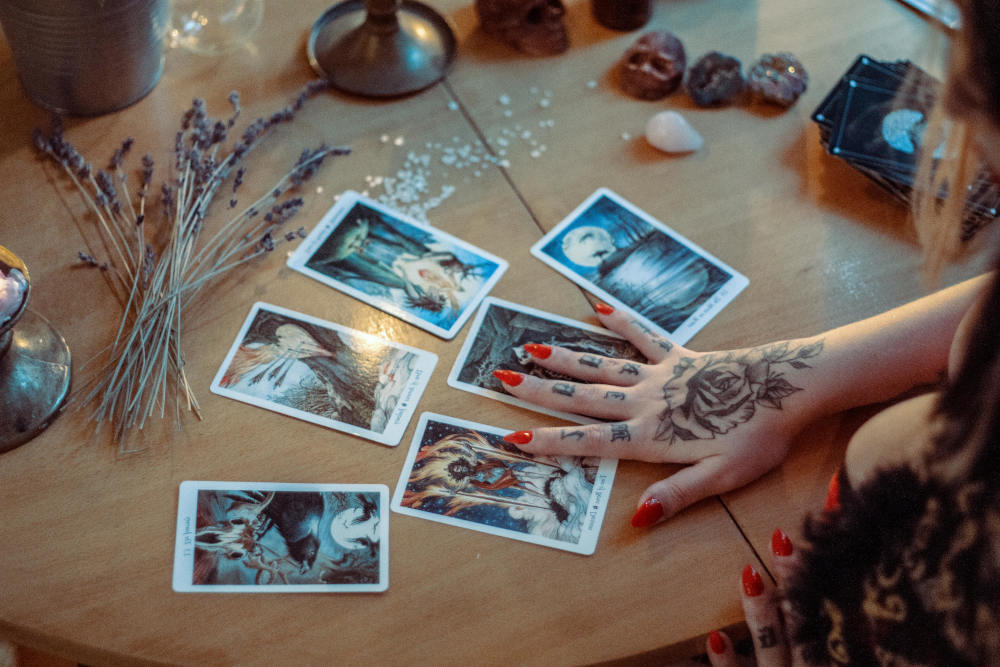
Die Wahl Ihres ersten Tarotdecks ist eine sehr persönliche und oft aufregende Reise. Bei der großen Auswahl – von klassisch bis modern, von minimalistisch bis reich illustriert – kann man sich als Anfänger schnell überfordert fühlen. Bei der Suche nach dem richtigen Tarotdeck geht es jedoch nicht darum, das beliebteste oder teuerste zu wählen. Es geht darum, ein Deck zu finden, das zu Ihnen passt – zu Ihrer Intuition, Ihrem Lernstil und Ihrer persönlichen Energie.
Dieser Artikel führt Sie durch den Prozess der Auswahl Ihres ersten Tarotdecks, erklärt die unterschiedlichen Decktypen und gibt Tipps, die Ihnen helfen, Ihre Tarotreise selbstbewusst zu beginnen.
Panaprium ist unabhängig und wird vom Leser unterstützt. Wenn Sie über unseren Link etwas kaufen, erhalten wir möglicherweise eine Provision. Wenn Sie können, unterstützen Sie uns bitte monatlich. Die Einrichtung dauert weniger als eine Minute und Sie werden jeden Monat einen großen Beitrag leisten. Danke schön!
Was ist ein Tarotdeck?
Ein Tarotdeck besteht aus 78 Karten, die zur Wahrsagerei, spirituellen Erkenntnis oder persönlichen Entwicklung verwendet werden. Jedes Deck besteht aus:
-
22 Karten der Großen Arkana : Repräsentieren die spirituellen Lektionen und großen Themen des Lebens.
-
56 Karten der kleinen Arkana : Repräsentieren alltägliche Erfahrungen, Emotionen und Herausforderungen. Diese sind in vier Farben (Stäbe, Kelche, Schwerter und Münzen) unterteilt, jede mit 14 Karten (10 nummerierte und 4 Bildkarten).
Während die Struktur gleich bleibt, können Kunst, Symbolik und Interpretationen zwischen den Decks erheblich variieren. Deshalb ist die Wahl des richtigen Decks wichtig.
Schritt 1: Verstehen Sie die verschiedenen Arten von Tarotdecks
Bevor Sie ein Tarotdeck kaufen, ist es wichtig, die wichtigsten Stile oder Systeme zu kennen:
1. Rider-Waite-Smith (RWS)
-
Das anfängerfreundlichste und am weitesten verbreitete System.
-
Erstellt 1909 von Arthur Edward Waite und der Künstlerin Pamela Colman Smith.
-
Reich an klaren Bildern, Symbolen und zugänglichen Reiseführern.
-
Viele moderne Decks basieren auf dieser Struktur.
-
Aufgrund der umfangreichen verfügbaren Lernressourcen am besten für Anfänger geeignet .
2. Thoth-Tarot
-
Erstellt von Aleister Crowley und gemalt von Lady Frieda Harris in den 1940er Jahren.
-
Komplex, esoterisch und basierend auf Thelema, Astrologie und Kabbala.
-
Eindrucksvolle Bilder, aber nicht ideal für absolute Anfänger.
3. Tarot von Marseille
-
Eines der ältesten Tarotsysteme mit Kunst im Holzschnittstil.
-
Die Karten der kleinen Arkana sind „Ziffernkarten“, das heißt, sie zeigen Zahlen und Farben ohne illustrierte Szenen.
-
Besser für intuitive oder numerologiebasierte Lesungen.
Tipp für Anfänger : Beginnen Sie mit einem RWS-basierten Deck, es sei denn, Sie fühlen sich stark zu einem anderen System hingezogen.
Schritt 2: Lassen Sie sich von Ihrer Intuition leiten
Tarot ist ein Werkzeug der Intuition, und die Wahl eines Kartenspiels sollte genauso beginnen. Schauen Sie sich Bilder verschiedener Kartenspiele online oder persönlich an. Fragen Sie sich:
-
Sprechen mich die Bilder an?
-
Fühle ich mich neugierig, getröstet oder inspiriert?
-
Fühlt sich das Deck wie etwas an, mit dem ich gerne Zeit verbringen würde?
Sie müssen nicht jedes Symbol sofort verstehen. Entscheidend ist, ob die Kunst Sie emotional oder visuell anspricht.
Schritt 3: Berücksichtigen Sie das Kunstwerk und den Stil
Die Kunstwerke bestimmen die Stimmung für Ihre Lesungen. Manche Decks sind skurril, andere düster, spirituell, modern oder naturbezogen. Überlegen Sie, was Sie anzieht:
-
Bevorzugen Sie realistische Kunst oder abstraktes Design ?
-
Fühlen Sie sich zu leuchtenden Farben oder Erdtönen hingezogen?
-
Möchten Sie ein Deck mit vielfältiger Darstellung , inklusiven Charakteren oder Fabelwesen ?
Ein Deck mit klaren und ausdrucksstarken Illustrationen kann Ihnen helfen, Bedeutungen leichter zu interpretieren – insbesondere am Anfang.
Schritt 4: Überlegen Sie sich das Thema oder den Zweck
Einige Tarotdecks sind um ein bestimmtes Thema oder kulturelles System herum gestaltet, wie zum Beispiel:
-
Natur und Tiere
-
Astrologie oder Mondphasen
-
Griechische, nordische oder ägyptische Mythologie
-
Feministische, LGBTQ+- oder spirituelle Empowerment-Themen
Die Wahl eines Themas, das Ihre Interessen widerspiegelt, kann Ihre Verbindung zu den Karten vertiefen. Wenn Sie spirituell, künstlerisch veranlagt oder von bestimmten Symbolen (wie dem Mond oder Wölfen) angezogen werden, wählen Sie ein Deck, das diesen Interessen entspricht.
Schritt 5: Lesen Sie Bewertungen und Beschreibungen
Bevor Sie ein Deck kaufen, lesen Sie Testberichte, Walkthroughs oder Videos. So erfahren Sie:
-
Kartenqualität und -größe (sind sie zu groß oder zu klein für Ihre Hände?)
-
Qualität des Reiseführers (ist er anfängerfreundlich und übersichtlich?)
-
Design der Kartenrückseite (kann man sie umkehren, um die Bedeutung umzukehren?)
-
Wie gut sich die Karten mischen lassen (einige Decks sind steif oder glänzend)
YouTube und Tarot-Review-Blogs sind großartige Ressourcen, um die Karten in Aktion zu sehen.
Schritt 6: Lesen Sie den Leitfaden
Ein anfängerfreundlicher Leitfaden ist unerlässlich. Viele Decks werden mit einem kleinen weißen Buch geliefert, aber nicht alle sind gleichermaßen hilfreich. Suchen Sie als Anfänger nach einem Leitfaden, der Folgendes enthält:
-
Klare aufrechte und umgekehrte Bedeutungen
-
Erklärung von Symbolen oder Bildern
-
Tipps zum Lesen oder Spreads
-
Übungen oder Tagebucheinträge
Einige Anfängerdecks, wie The Modern Witch Tarot oder The Light Seer’s Tarot , werden mit ausführlichen, farbigen Anleitungen geliefert.
Schritt 7: Entscheiden Sie, wo Sie kaufen möchten
Sie können Tarotdecks kaufen bei:
-
Lokale Metaphysik-Läden : Sie können die Karten berühren und persönlich sehen.
-
Online-Händler : Amazon, Etsy und spezielle Tarot-Websites wie The Tarot Garden oder Little Red Tarot bieten eine große Auswahl.
-
Direkt von den Entwicklern : Viele Indie-Decks sind über Kickstarter oder Künstler-Websites erhältlich.
Hinweis : Der alte Mythos, dass Ihr erstes Tarotdeck ein Geschenk sein muss, ist überholt. Es ist völlig in Ordnung – und bestärkend –, sich ein eigenes zu kaufen.
Schritt 8: Wählen Sie zwischen Massenmarkt- und Indie-Decks
Massenmarkt-Decks:
-
Weit verbreitet im Handel oder online erhältlich
-
Günstiger (normalerweise 20–30 $)
-
Oft von großen Unternehmen wie US Games oder Hay House veröffentlicht
Indie-Decks:
-
Im Selbstverlag von Künstlern oder kleinen Kreativen
-
Einzigartiger und künstlerischer
-
Teurer (40–70 $+), aber oft von höherer Qualität und ethisch produziert
Für Anfänger ist ein Massenmarktdeck möglicherweise praktischer, aber wenn Sie ein bestimmtes Indie-Deck anspricht, haben Sie keine Angst, diesem Ruf zu folgen.
Schritt 9: Berücksichtigen Sie die Kartengröße und das Gefühl
Die Kartengröße ist wichtiger, als Sie vielleicht denken. Manche Decks sind übergroß und mit großen Bildern versehen, aber schwer zu mischen. Andere sind kompakt und ideal für unterwegs. Wählen Sie als Anfänger ein Deck mit:
-
Standard-Tarotgröße (ca. 2,75 x 4,75 Zoll)
-
Mattes oder halbmattes Finish (weniger rutschig)
-
Robuster Karton , der sich nicht schnell abnutzt
Wenn Sie kleine Hände haben, ist ein Kartenspiel mit der Aufschrift „Pocket“ oder „Mini“ vielleicht das Richtige für Sie.
Schritt 10: Beginnen Sie mit einem Klassiker, wenn Sie unsicher sind
Wenn Sie sich immer noch unsicher fühlen, beginnen Sie mit einem dieser anfängerfreundlichen Decks:
1. Rider-Waite-Smith (Original)
-
Das klassische Deck mit erkennbarer Symbolik
-
Erschwinglich und mit vielen Online-Ressourcen
2. Das moderne Hexen-Tarot
-
Eine vielfältige, feministische Variante des RWS-Decks
-
Kommt mit einem ausführlichen Reiseführer
3. Das Tarot des Lichtsehers
-
Beliebt für seine intuitive, emotionale Kunst
-
Ideal für moderne Leser, die eine gefühlvolle Atmosphäre wünschen
4. Alltags-Tarot
-
Kompakt und minimalistisch
-
Ideal für Tagebucheinträge und tägliche Auszüge
Letzte Tipps für Anfänger
-
Reinigen Sie Ihr Deck , wenn Sie es erhalten, indem Sie es beschmieren, darauf klopfen oder es ins Mondlicht legen.
-
Bewahren Sie es sorgfältig auf , entweder in der Schachtel, einem Beutel oder auf Ihrem Altar.
-
Üben Sie regelmäßig . Ziehen Sie täglich eine Karte, um sich mit deren Bedeutung vertraut zu machen.
-
Führen Sie ein Tagebuch über Ihre Lesungen, um Ihr Wachstum und Ihre intuitiven Erkenntnisse zu verfolgen.
-
Seien Sie geduldig . Es braucht Zeit, eine Beziehung zu Ihrem Deck aufzubauen.
Abschluss
Die Wahl Ihres ersten Tarotdecks ist eine Einladung, Ihre innere Welt, Ihre Intuition und Ihre Kreativität zu erkunden. Es gibt nicht das richtige Deck für jeden – nur das richtige Deck für Sie . Vertrauen Sie Ihrem Instinkt, entdecken Sie verschiedene Stile und machen Sie sich keinen Stress, die perfekte Wahl zu treffen. Das richtige Deck wird sich wie ein alter Freund anfühlen, den Sie endlich wiedergetroffen haben.
Egal, ob Sie sich zu klassischer Symbolik, mystischen Kunstwerken oder verspielten Themen hingezogen fühlen, Ihre Tarot-Reise beginnt in dem Moment, in dem Sie das Deck auswählen, das Ihre Seele anspricht.
War dieser Artikel hilfreich für Sie? Bitte teilen Sie uns in den Kommentaren unten mit, was Ihnen gefallen oder nicht gefallen hat.
About the Author: Alex Assoune
Wogegen Wir Kämpfen
Weltweit-Konzerne produzieren in den ärmsten Ländern im Übermaß billige Produkte.
Fabriken mit Sweatshop-ähnlichen Bedingungen, die die Arbeiter unterbezahlt.
Medienkonglomerate, die unethische, nicht nachhaltige Produkte bewerben.
Schlechte Akteure fördern durch unbewusstes Verhalten den übermäßigen Konsum.
- - - -
Zum Glück haben wir unsere Unterstützer, darunter auch Sie.
Panaprium wird von Lesern wie Ihnen finanziert, die sich unserer Mission anschließen möchten, die Welt völlig umweltfreundlich zu gestalten.
Wenn Sie können, unterstützen Sie uns bitte monatlich. Die Einrichtung dauert weniger als eine Minute und Sie werden jeden Monat einen großen Beitrag leisten. Danke schön.































0 Kommentare